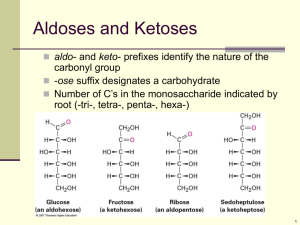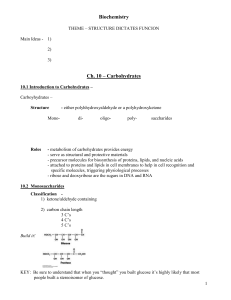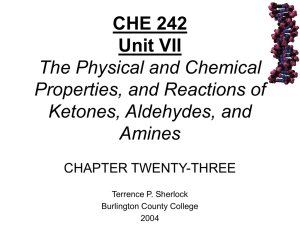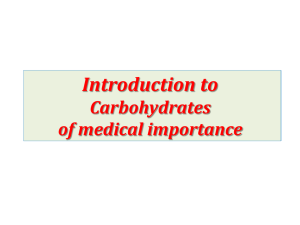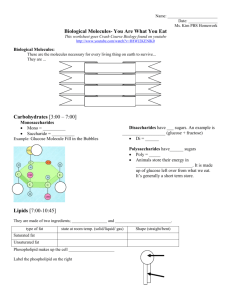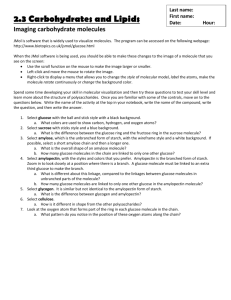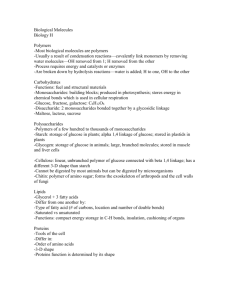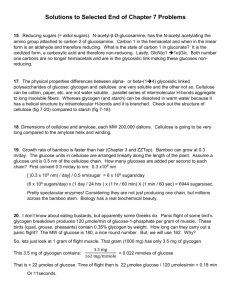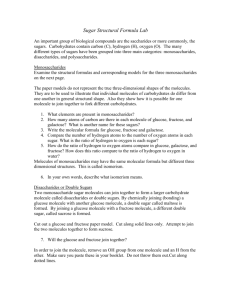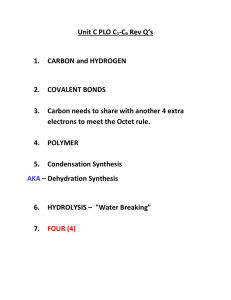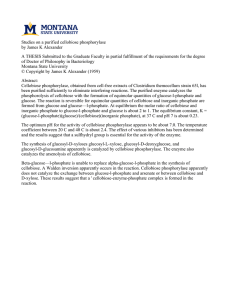Basic Organic Chemistry g y 2302202
advertisement
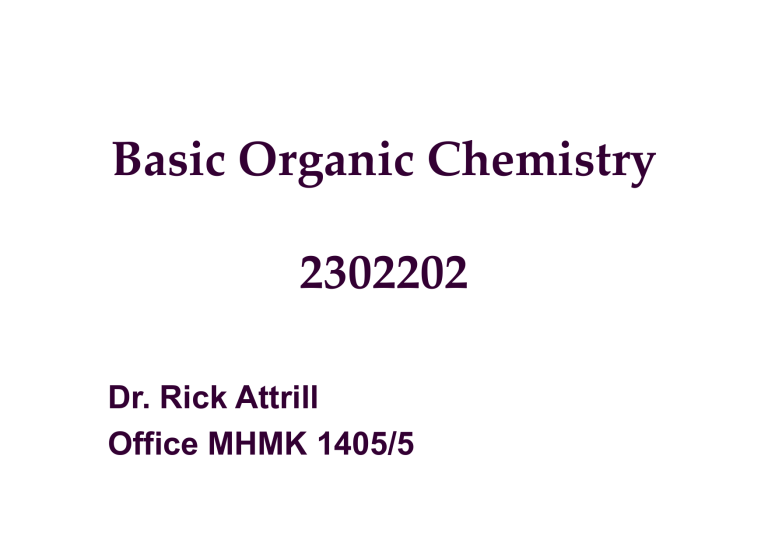
Basic Organic g Chemistry y 2302202 Dr. Rick Attrill Office MHMK 1405/5 Carbohydrates II Reactions of Monosaccharides Disaccharides Di h id and dP Polysaccharides l h id 2 Reactions of Monosaccharides OH groups can be converted into esters and ethers, which are often easier to work with than the free sugars and are soluble in organic solvents. Esterification by treating with an acid chloride or acid anhydride h d id iin th the presence off a b base All OH groups react 3 Ethers Eth Treatment with an alkyl halide in the presence of y base—the Williamson ether synthesis Use silver oxide as a catalyst with base-sensitive compounds 4 Gl Glycoside id F Formation ti Treatment of a monosaccharide hemiacetal with an y yields y an acetal in which alcohol and an acid catalyst the anomeric OH has been replaced by an OR group -D-glucopyranose with methanol and acid gives a mixture of and methyl D-glucopyranosides 5 Gl Glycosides id Carbohydrate acetals are named by first citing the alkyl y g group p and then replacing p g the -ose ending g of the sugar with –oside Stable in water,, requiring q g acid for hydrolysis y y 6 S l ti F Selective Formation ti off C1-Acetal C1 A t l Synthesis requires distinguishing the numerous OH groups g p Treatment of glucose pentaacetate with HBr converts anomeric OH to Br Addition of alcohol (with Ag2O) gives a glycoside (Koenigs–Knorr reaction) 7 Koenigs-Knorr g Reaction Mechanism and anomers of tetraacetyl-D-glucopyranosyl bromide give -glycoside Suggests either bromide leaves and cation is stabilized by neighboring acetyl nucleophile from side Incoming I i alcohol l h l di displaces l acetyl t l oxygen tto give i glycoside R d ti off M Reduction Monosaccharides h id Treatment of an aldose or ketose with NaBH4 reduces it to a polyalcohol (alditol) Reaction via the open-chain form in the aldehyde/ketone hemiacetal equilibrium 9 Oxidation of Monosaccharides Aldoses are easily oxidized to carboxylic acids by: Tollens' reagent (Ag+,aq. NH3) (gives a Ag “metallic mirror”), Fehling's reagent (Cu2+, sodium tartrate) (forms a red Cu20 ppt.), ppt ) Benedict Benedict`ss reagent (Cu2+, sodium citrate) (forms a red Cu20 ppt.) Ketoses are reducing sugars if they can isomerize to aldoses 10 Oxidation of Monosaccharides O with Bromine Br2 in water is an effective oxidizing reagent for converting aldoses to carboxylic acid, called aldonic acids (the metal reagents are for analysis only) 11 Formation of Dicarboxylic Acids Warm dilute HNO3 oxidizes aldoses to dicarboxylic acids, called aldaric acids The CHO CHO group and the terminal CH CH2OH group are oxidized to COOH C Chain Lengthening: g g The Kiliani–Fischer Synthesis Lengthening aldose chain by one CH(OH), an aldopentose ld t i converted is t d iinto t an aldohexose ld h 13 Kili i Fi h Synthesis Kiliani-Fischer S th i Method M th d Aldoses form cyanohydrins with HCN Follow by hydrolysis, hydrolysis ester formation formation, reduction Modern improvement: reduce nitrile over a palladium catalyst yielding an imine intermediate that is catalyst, hydrolyzed to an aldehyde 14 Stereoisomers from Kiliani-Fischer Synthesis Cyanohydrin is formed as a mixture of stereoisomers at the new chirality center center, resulting in two aldoses 15 Chain Shortening: The Wohl Degradation Shortens aldose chain by one CH2OH 16 Di Disaccharides h id A disaccharide combines a hydroxyl of one monosaccharide in an acetal linkage with another A glycosidic bond between C1 of the first sugar ( or ) and the OH at C4 of the second sugar is particularly common (a 1,4 link) 17 M lt Maltose and d Cellobiose C ll bi Maltose: two D-glucopyranose units with a 1,4--glycoside gy bond ((from starch hydrolysis) y y ) Cellobiose: two D-glucopyranose units with a 1,4--glycoside bond (from cellulose hydrolysis) 18 H i Hemiacetals t l iin Di Disaccharides h id Maltose and cellobiose are both reducing sugars The and anomers equilibrate, equilibrate causing mutarotation 19 Y C You Can’t ’t E Eatt Cellobiose C ll bi The 1-4’--D-glucopyranosyl linkage in cellobiose is not attacked by any digestive enzyme The Th 1-4’-1 4’ D-glucopyrnaosyl l l lilinkage k iin maltose lt is i a substrate for digestive enzymes and cleaves to give glucose 20 L t Lactose A disaccharide di h id th thatt occurs naturally t ll iin milk ilk Lactose is a reducing sugar. It exhibits mutarotation It is 1,4’--D-galactopyranosyl-D-glucopyranoside The structure is cleaved in digestion g to g glucose and galactose 21 Sucrose “Table “T bl Sugar” S ” is i pure sucrose, a disaccharide di h id th thatt hydrolyzes to glucose and fructose Not a reducing sugar and does not undergo mutarotation (not a hemiacetal) Connected as acetal from both anomeric carbons (aldehyde to ketone) 22 P l Polysaccharides h id Complex carbohydrates in which very many simple sugars are linked Cellulose and starch are the two most widely occurring polysaccharides 23 C ll l Cellulose Consists of thousands of D-glucopyranosyl 1,4-- glucopyranosides as in cellobiose Cellulose C ll l molecules l l fform a llarge aggregate t structures held together by hydrogen bonds Cellulose C ll l iis th the main i componentt off wood d and d plant l t fiber 24 Starch and Glycogen Starch is a 1,4 1,4--glupyranosyl-glucopyranoside glupyranosyl glucopyranoside polymer It is digested g into g glucose There are two components amylose, insoluble in water – 20% of starch 1,4’--glycoside polymer amylopectin, amylopectin soluble in water – 80% of starch 25 Amylopectin More M complex l iin structure t t than th amylose l Has 1,6--glycoside branches approximately every 25 glucose units in addition to 1,4--links 26 Glycogen Gl A polysaccharide that serves the same energy g function in animals that starch serves in storage plants Highly branched and larger than amylopectin—up to 100,000 glucose units 27 Oth Important Other I t t Carbohydrates C b h d t Deoxy sugars have an OH group is replaced by an H. H. Derivatives of 2-deoxyribose are the fundamental units of DNA (deoxyribonucleic acid) 28 Amino Sugars OH OH group is replaced by an NH NH2 Amino sugars are found in antibiotics such as streptomycin and gentamicin Occur in cartilage 29
